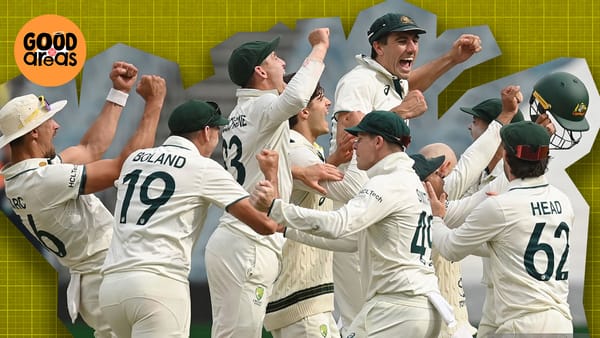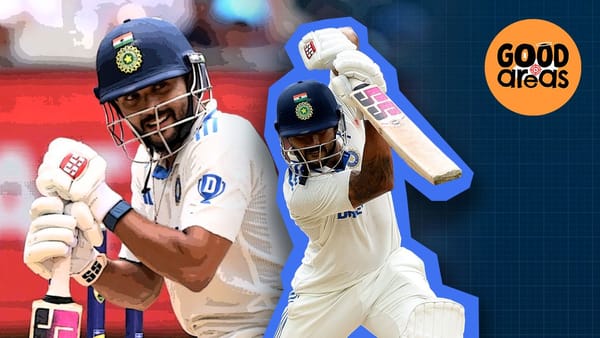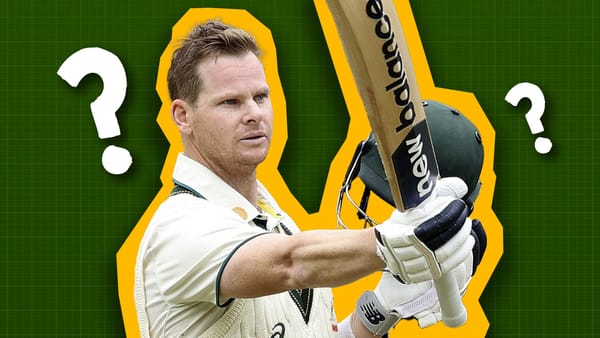Keshav Maharaj and the rupture
An injury that doesn't happen in cricket much might end Maharaj's World Cup
The moment Keshav Maharaj’s life changed looked pretty innocuous.
Maharaj is bowling around the wicket to Kyle Mayers in what is clearly going to be a huge win for South Africa. The umpire Paul Reiffel gives it not out, South Africa refer, and even though Mayers comes down the wicket, it’s clear it should have been given and so then the bowler celebrates. Until he doesn’t.
He starts to run because of his wicket until he crumples on the field and has to be taken from the pitch on a stretcher.
Because this is the moment that Keshav Maharaj ruptured his Achilles heal.
And if you missed it live, that is because it’s not something that usually looks that massive.
This is Kevin Durant in the NBA playoffs.
You can see that almost nothing happens here at all, he dribbles one way, stops, is about to come back another direction and then something goes wrong. His foot stops working. This happened in June 2019, his next game was in December 2020. Some of that delay was Covid-related, but Achilles injuries are horrific.
A rupture of Achilles means a tear of the tendon connecting the calf and heel. If you just shivered, you are right. For a short time, the pain was agonising. They generally come from high-intensity changes of direction or jumping. That is why basketballers get them. Tennis and football are other sports which see a lot of these injuries as well.
It isn’t that cricket has never had any Achilles injuries. Matt Prior’s career was cut short by his Achilles when he couldn’t even get from his hotel bed to the bathroom.
Josh Hazlewood had an Achilles that ruled him out of this series. And Kevin Pietersen was also someone who hurt his Achilles and had to have an operation. But these weren’t ruptured. I did find some that were.
Queensland keeper Georgia Redmayne is currently rehabbing from a ruptured Achilles. She has an advantage over other people though, as she is also a doctor. Not sure if that helps her recover quicker though.
But we have two spinners with this injury that we can look at.
JP Duminy was very much a part-time spinner, but he certainly bowled. And in 2012 he ruptured his Achilles at the Gabba in the post-play warm-down. He didn’t even get on the field that day, which is why the team were taking him out for some work.
That was on the 9th of November, and Duminy’s next match was on 31 May 2013. He bowled five overs of off-spin against the Netherlands and they continued to bowl in the Champions Trophy for South Africa.
The second is Liam Dawson. A player who has been more on the fringes of England than Duminiy. But he’s a left-arm orthodox who bats. He ruptured his taking off for a single, and heard the pop. He thought he stepped on the stumps. That was in august 2020. He didn’t play again until April 2021.
Now, the England summer and Covid played a part in his long layoff. But he did usually play a T20 tournament or two in the offseason. Dawson bowls a bit more than Duminy. If Duminy was a proper part-timer, then Dawson is more of a solid fifth option with the ball.

Either way, both players took around seven to eight months to come back.
We are seven months from the start of the World Cup.
There are some good signs for Maharaj though, he injured the right foot. By that I mean he injured his left. For a finger spinner, the front foot is the one that would stress a finger spinner the most as they rotate on that foot as they land, and often it’s in the air. The fact he has injured his left foot might help. Dawson and Duminy both injured their front foot.
Perhaps that might allow Maharaj to come back quicker. There have been athletes who have recovered as quickly as four months from this injury at times.
Currently, Maharaj is the face of new South African spin. As their wickets change to help tweakers more, he has become an automatic section in their Test side. And not as a novelty like Paul Adams, an experiment like Imran Tahir, or just to bowl the dog overs like Paul Harris. He is a genuine frontline spinner who is on his way to being the highest wicket-taking Test spinner in South African history. Only the great Hugh Tayfield has him covered.

It’s an unlikely record for a player who made his professional debut in 2006 but took ten years to play his first international.
Looking at his record it doesn’t make much sense. Maharaj was doing well pretty much from the time he made his debut. By 2012 he certainly looked like an international player. You can see his first-class average each year at home was really solid, and on occasion, incredibly low. But a lot of this is in the lower division of first-class cricket. For the Dolphins he still mainlined a sub-30 average from 2012-2016, but he only played full seasons in the last two years. This was South Africa, and a spinner takes what he can get.

Those were the Imran Tahir experimental years for South Africa. And Maharaj would have been a good option, but they wanted Tahir to work. So it was at the end of 2016 when Maharaj finally got his chance.

His first full year was in 2017, and in that, he took the seventh most wickets in the world. Just under Ravi Jadeja and Rangana Herath, two other pretty good left-arm spinners. His average was 23 as well.

Since his debut, he has the 12th-most wickets in all Tests. This is not a normal thing for a South African spinner. The fact he’s also done it at an average of 32 - which is very good for a spinner from South Africa - just shows how important he has been. He has really been like a left-armed version of Nathan Lyon. Giving South Africa proper overs, and taking enough wickets to stay a constant threat.

He hasn’t been as good in ODI cricket, in part because South Africa haven’t been sure if they wanted him or Tabraiz Shamsi. At times both have played, but in the last three years, Maharaj has been the better of the two by a distance. Their averages are almost identical, but Maharaj goes a run a ball less per over.

On top of that, the World Cup is being played on Indian pitches. So the finger spin is fairly important. If Maharaj isn’t fit, that is a huge problem. You can also throw his batting in there. While he is not a plus on that end, his not being a total zero allows them to continue with their plan to not ever pick a number seven who can bat.
He is an important player for South Africa to lose. They are currently around nine to one to win that World Cup. Weirdly this hasn’t changed their odds, where in truth, even if Maharaj isn’t a frontline star, for India, he’s important enough to note.
For Maharaj missing the main tournament would be a drag, but perhaps more is how his future goes from here. It took him a decade to break into the national team. In Tests, he contends with Simon Harmer. In white ball cricket, it is Tabraiz Shamsi. Suddenly South Africa have a platoon of spin available.
And not all players recover well from a ruptured Achilles. It takes away your athleticism, now for a finger spinner, that might not seem as important. But for a 33-year-old spinner, who will be nearer 34 when the next time he plays, it might.
Maharaj forced his way into a culture that doesn’t trust spin and is on his way to becoming their highest-ever wicket-taker in Tests. He is a player who gives his all across three disciplines. Is incredibly professional and works very hard. He deserves a chance at a World Cup, and he certainly deserves better than this




